InTouch
InTouch (FS120075) is the system that helps you to communicate at all Scout activities and events. It's flexible and lets Groups and Sections work out the best way to keep in touch during these activities.
(FS120075) Published April 2020, replacing March 2015
Introduction to the InTouch system
Whenever any activity, event or meeting is run within Scouts, it's a requirement that an InTouch system is put in place (POR 9.1). This is to make sure:
- everyone involved is aware of how communication will take place between the Leaders, volunteers, young people, parents and carers, and those not at the event
- there are details of who's present should anything go wrong and there's a system in place in the event of an emergency.
The procedures put in place to ensure this are likely to vary at different types of events due to the differing circumstances and needs. To facilitate this, InTouch is a process that you must follow to make sure that everyone is clear as to what will be put in place for every Scouts event.
When to use an InTouch system
As the reasons for having InTouch remain the same for all types of activities and events, an InTouch system needs to be in place for every event or activity within Scouts.
This is the case from the regular weekly meeting, through to the multiple-week international expedition and from the Beaver Scout games evening, to the Scout Active Support residential. Naturally these examples are likely to use very different procedures, but they'll need to go through the process and define what procedures they'll be using.
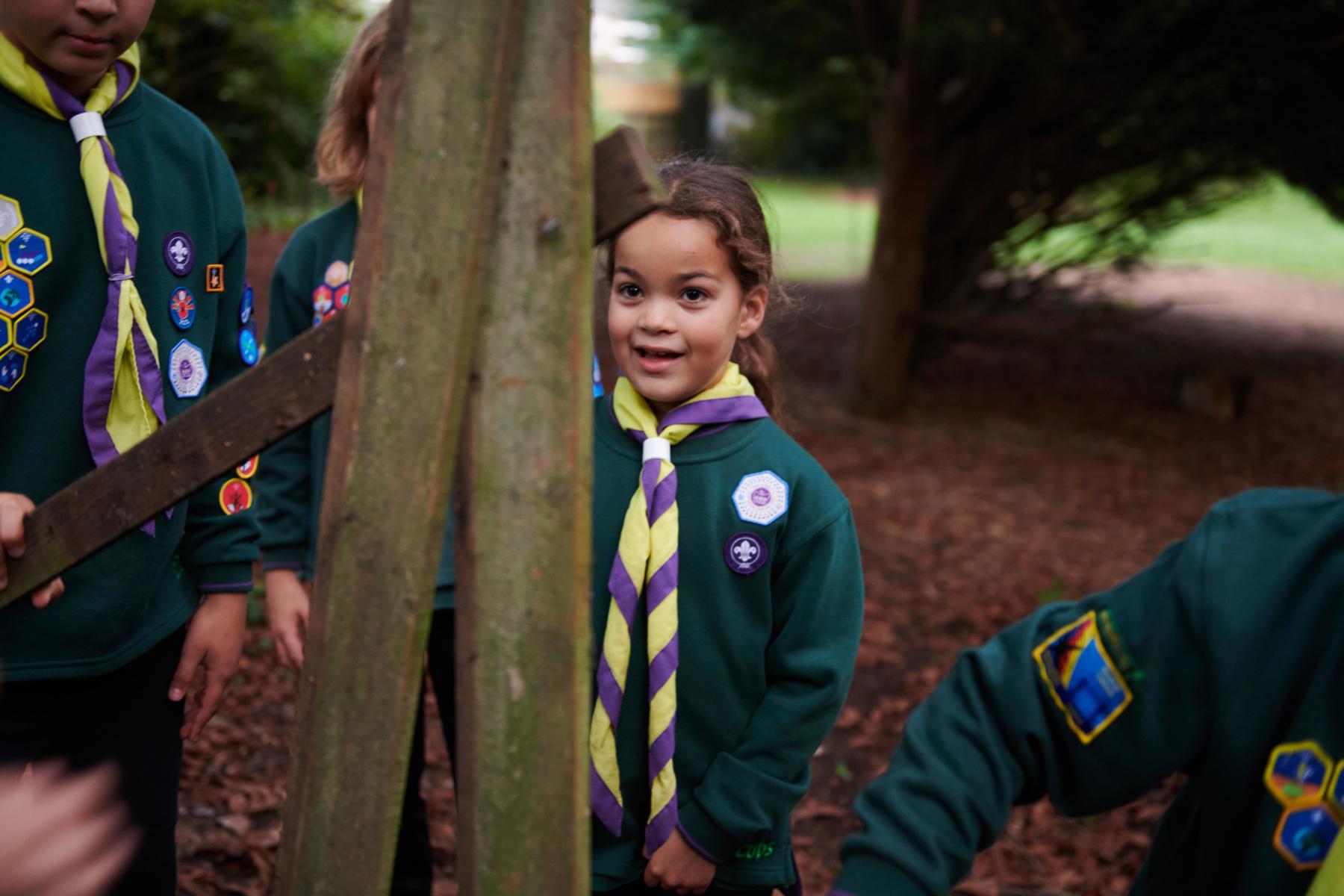
Setting up an InTouch system
Here's a step-by-step approach guiding you through the process of setting up an InTouch system, as well further guidance on areas and issues to look at within this and suggestions on how these can be managed.
Areas to think about:
- How will you hold the details of all those taking part in an event, and the contact details of their parents and carers, or emergency contact/next of kin, so that they can be accessed as required?
- What system will you use if you need to contact a parent or carer individually? For example, informing them of a slight injury to a participant requiring first aid.
- What system will you use if you need to contact all parents and carers at the same time? For example, informing them that the coach has been held up and will be back an hour later than previously stated.
- What guidelines have you given to parents and carers about how or when they'll be communicated with throughout the event?
Areas to think about:
- What contact details of the Leaders will you give to the parents and carers?
- What advice or guidelines will be given to parents and carers as to how to contact the event and when/why communication is expected or appropriate?
Areas to think about (not only during peer-led activities, but also when young people are given more independence during volunteer-led activities):
- What contact details of the Leaders will you give to the participants?
- What advice or guidelines will be given to participants as to how to contact the Leaders?
- What advice or guidelines given to participants as to when/why communication is expected or appropriate?
- How will you make sure you follow the Yellow Card and Staying Safe online guidance?
Areas to think about:
- What system and level (if any) of communication will there be between participants and parents and carers?
- Will mobile phones, use of social media (or similar) be allowed at the event? If so, what guidelines are in place?
Areas to think about:
- Do records of all those present need to be held by anyone away from the event and, if so, by who?
- How will you contact your Commissioner or their designate in the case of an emergency (as per POR Chapter 7 - Emergency Procedures) at any point during the event?
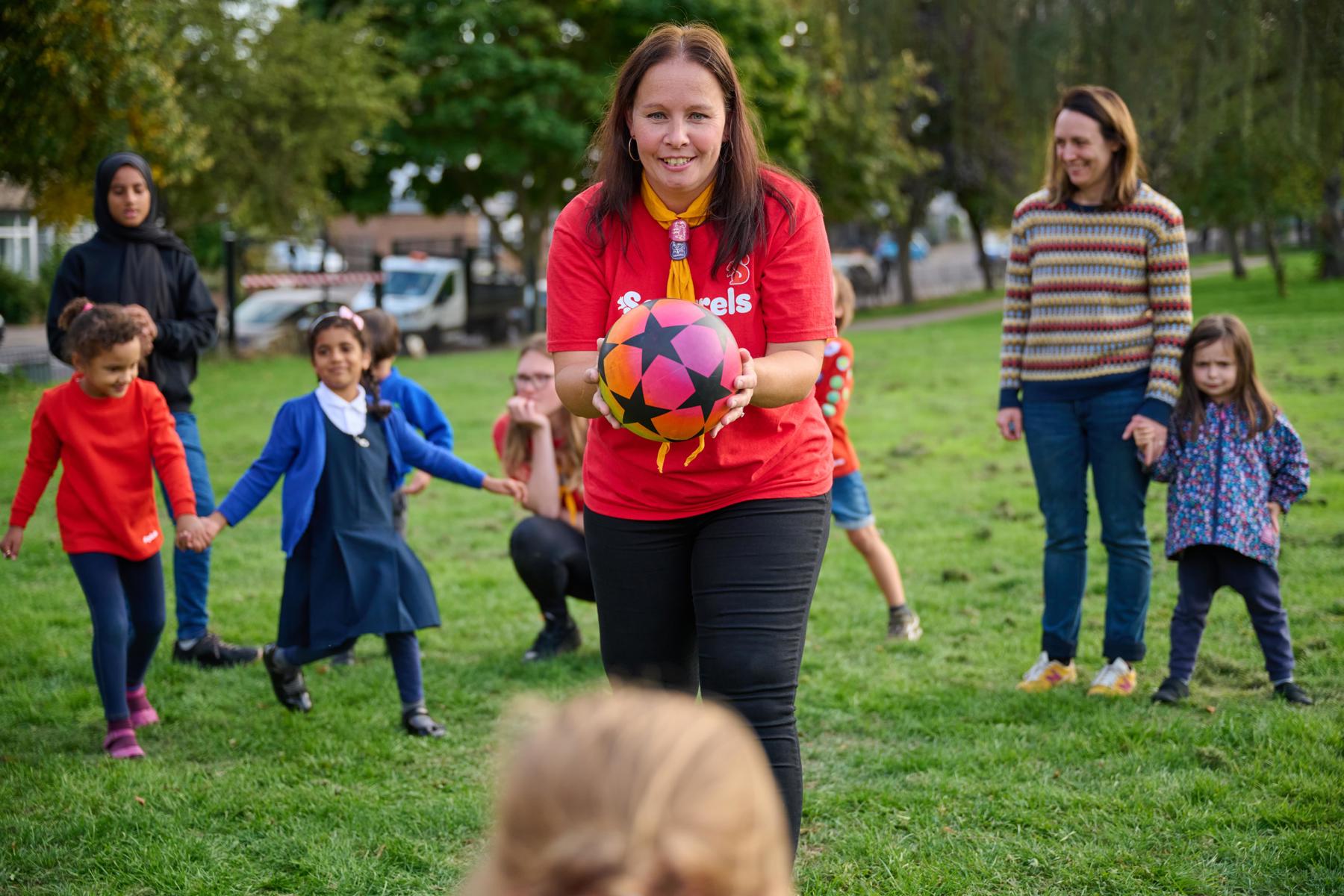
The process
- ‘Leaders’ refers to those volunteers running or at an event, as well as volunteers responsible for an event, but not present.
- ‘Parents’ refers to parents and carers and/or next of kin.
- ‘Participants’ refers to young people taking part in an activity.
- ‘Meeting Place’ refers to the regular building or location a section, Group, or Unit meet in.
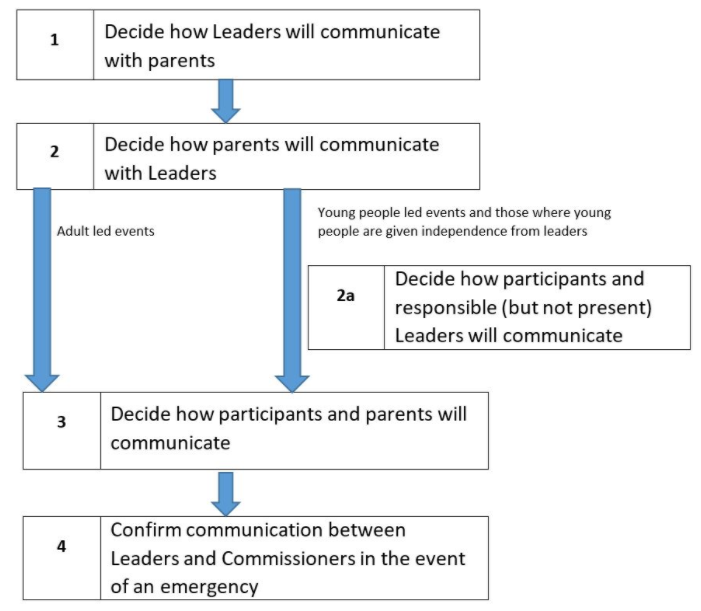
The reasons for having InTouch in place are just as valid for the weekly meeting as they are for events away from your meeting place.
Therefore, it's important to have an InTouch system set up for these meetings as well. This doesn’t mean lots of extra work and a third party required every week. It's simply that you need to go through the process to make sure a system is in place that can then be used for all your meetings.
It's likely that most of, or all of, these things that the InTouch process highlights are things you'll be doing already, such as:
- parents and carers knowing the phone number for the meeting place and Leaders
- parents and carers providing their details, including details of next of kin or emergency contact for all new members
- having a plan in place for emergencies
In some situations (possibly events that take place over a longer period or overseas), it can be useful to have a third party/parties away from the event to be the central point for communications.
This can take the pressure off Leaders to allow them to concentrate on running the event.
In situations such as these, the third party will need to have the details of everyone attending the event and emergency contact details for their next of kin. They should also have a copy of the Emergency Procedures Card.
They'll need to be available to be contacted throughout the length of the event. As they'll have the personal and contact details of the young people involved, they'll also need to have completed a Personal Enquiry.
If relying on a third party, it's important to think about what'll happen if there's an incident that requires their involvement, but one of the people affected by the incident is related to or well-known by the third party.
Would they be in a position to, or be expected to carry out their role? If not, how will that communication take place?
Each volunteer team will have their own systems of holding records for the young people in their care. This might be through the personal detail record cards, activity information forms, a database or other means.
If this is data you already hold, you'll need to ensure you've a procedure for making sure it's kept up to date. To avoid duplication of data, it should be possible to use these records for each event (amended as and if necessary), including providing details for any third party involved.
Rather than filling out any new form it'll generally be easier to provide copies of the records you hold for this third party.
Find out more about data protection and record management.
The emergency procedures of The Scout Association are clearly defined in POR Chapter 7.
To make this process as simple and straight forward as possible for those running an event, you can get an Emergency Procedure Prompt Card that can be kept on you and in the case of an emergency will take you step by step through the process.
It's important to include adults within any InTouch system that you have in place.
This is the case for adults, such as volunteers and parent/carer helpers, at events for young people, as well as adults at adult only events, such as Scout Network or Scout Active Support events.
Don’t forget that when referring to ‘parents and carers’ this scheme also means next of kin or an emergency contact, which is likely to be more relevant for adults.
Mobile phones and access to the internet can be a very useful tool for your InTouch system. But, there are a number of issues that you need to think about if you're going to use them:
- Will there be a signal or internet access where you are? What will you do if there is no signal?
- Will volunteers use their personal devices or could you have a Group phone?
- Will you be able to charge the device, and if not, what will you do if the battery dies? You could take a charger, a second device or a portable power bank.
- If you're storing all of the contact details on one of these devices, and the battery then dies, how will you find these details if you need them? How will you keep any digital printed copies of personal details safe and secure?
- If the young people have mobile phones or other devices and contact their parents and carers, or peers, about anything happening during the event, how will you know what has been shared?
It may be useful to have some sort of agreement with the young people and their parent and carers to include areas, such as:
- When it's acceptable to use phones or the internet
- What they're not acceptable for
- How to let volunteers know what information about the event you are sharing.
For large scale events, such as jamborees, District or County events, it's just as important that there's an InTouch System in place. This is the responsibility of the organisers and also those leading groups attending the event.
The organiser's InTouch System will look at what contingents and/or groups are attending and how they communicate with them.
The contingents and/or groups system will look at who is a member of their party and how to communicate with their parents and carers.
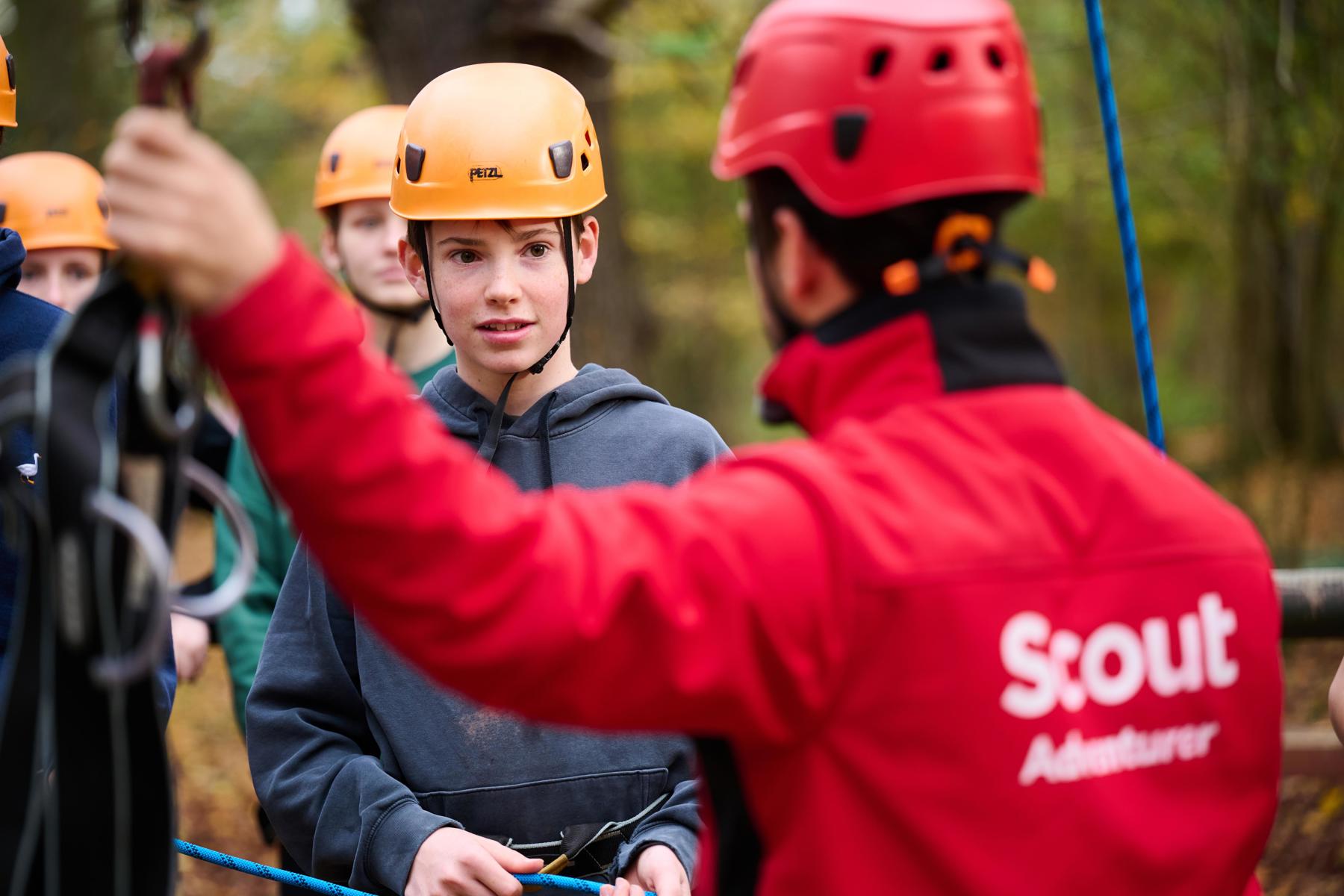
Examples of different types of InTouch systems
Here are some examples of the different types of InTouch system that should be set up for different events. They're included to demonstrate best practice in Scouts.
1. The Leaders hold written records of all youth and adult members in the section, both of which they take to each meeting. There's a phone at the meeting place, including charger, and a number of the adults have mobile phones with reception that can be used if contact is needed.
2. All parents and carers are given the number of the meeting place and of Leaders when their young people first join. Volunteers should encourage all parents and carers, young leaders and volunteers to inform them if contact details change.
3. Use of mobile phones and tablets are discouraged during meetings and there's no need for communication to/from parents and carers during the meeting.
4. Contact details of the District Commissioner and a copy of the Purple Card are available at the meeting place.
1. The Leaders hold records of all Beavers on their personal detail record cards, which they take to each meeting. Leaders will use their mobiles or the phone at the meeting place if contact is needed.
2. All parents and carers are given the number of the meeting place and of the Leaders when their young people first join. They're encouraged to communicate through the volunteers if they need to make contact with their young person while at Beavers. Regular checks are made to make sure contact details are current.
3. There's no need for communication to/from parents and carers during the meeting.
4. Contact details of the District Commissioner and a copy of the Purple Card are available at the meeting place.
1. The Leaders will bring the contact details of each Scouts' parents/carers throughout the camp from the Nights Away Information form. They'll use mobile phones for contact and have the campsite pay phone if there are problems with mobiles. They've a contact at home who's able to update the Group website with any messages that need to get to all parents and carers. The parents and carers are told not to expect any contact unless there's a problem and to check the website.
2. Parents and carers are given the mobile numbers of the Leaders and also the number of the campsite, but it's explained to them that these are only available in case of an emergency.
3. Mobile phones are discouraged for the event. Parents and carers and Scouts are made aware that there's no need for communication between them, and there's likely to be communication only if there's a problem. If any Scout does feel the need to communicate with their parents and carers, they need to discuss this with the Leaders as well.
4. Leaders take contact details for the District Commissioner and District Secretary, and also details of when each of them is likely to be available. Details of who is attending are left with the Group Scout Leader.
1. The Leaders hold personal details for all of their Explorers, which they take with them. They've mobile phones and a phone at the place they're staying. As there are only a few Explorers attending, they're happy they can contact all parents and carers if required.
2. Parents and carers are given the mobile numbers of the Leaders and also the number of the hostel, but it's explained to them that these are only available in the event of an emergency.
3. Communications with people not on the event are left to each individual, but all are made aware that it mustn't disrupt the activities. If there are any problems to do with the event, these are discussed with the leadership team immediately.
4. Leaders take contact details for the District Commissioner and District Secretary, and also details of their availability. Details of who is attending are left with the District Explorer Scout Commissioner.
1. Members are required to give next of kin details when they arrive at the event, and these are then held centrally. The organisers have mobile phones and the campsite pay phone if they need to contact anyone. They also have an event website that they can update with general messages.
2. Contact details of the organising team are made available.
3. Communications with people not on the event are left to each individual.
4. Organisers have contact details of the County Commissioner. They also keep a centralised record of those who have turned up at the event along with their next of kin details.
1. The caving team holds details (including next of kin) for all their members which they take on each event. They have mobile phones with them and there is a phone at the bunkhouse where they are staying.
2. The organisers contact details are included in all information provided about the event.
3. Communications with people not on the event are left to each individual.
4. Organisers have contact details of the County Commissioner and a list of which caving team members are attending.
1. The Leaders hold personal details for all of their Explorers which they'll have access to during the weekend. As they'll be at home, they'll have easy access to ways of communicating. Leaders make sure that all contact details are up-to-date.
2. All parents and carers are given the contact details of the Leaders when their young people first join.
3. All expedition members are given the contact details of their Leaders, and the Leaders will have mobile phone numbers for all expedition members and for where they are staying. The expedition members identify before they start where there are phones available on route in case of mobile phones not working, and also agree with their Leaders if/when they should report in.
4. Parents and carers and Explorers are made aware that there's no need for communication between them as part of the expedition. If there is a problem, the Leaders will get in contact with the parents and carers, as the Explorers may not be able to make contact.
5. The Leaders have contact details for the District Commissioner and details of who is taking part in the expedition.
1. The Leaders will have the contact details for each Scouts' parents/carers. They have mobile phones set up to be able to work from Switzerland to contact parents and carers individually if needed, and can also use the pay phones at Kandersteg International Scout Centre. They've two different parents or carers in the UK that they've left details of all those attending with, and will use one of these as a point of contact to share information if they need to contact multiple people.
2. Parents and carers are given the mobile numbers of the Leaders and the number of Kandersteg International Scout Centre, but it's explained to them that these are only available in the event of an emergency.
3. Mobile phones are discouraged at the event. Communication is made available at specific times if Scouts wish to contact home, but everyone is made aware beforehand that no communication is likely to mean that everything is going well and they're too busy to worry about contacting home! If there are any problems to do with the event that are discussed with parents and carers, then these must be discussed with the leadership team as well.
4. Leaders take contact details for the District Commissioner and District Secretary, and also details of their availability. The parents or carers acting as contact points have details of who's attending, in addition to the Leaders.
Contingent Events that are managed by HQ follow a different InTouch process to locally run events, because of the size and scale.
1. The Contingent will have a national contact who will be the link between the Contingent based at the event and the home contact. The national contact will be the point of contact for passing messages between the Contingent and home, and vice versa. The national contact is used for emergency contact only.
2. We request that, in the event of an emergency, parents and carers or family members contact their Scout member at the event via the national contact. This is so that the Contingent Management Team can offer support where required.
3. Each member of the Contingent must provide an accurate ‘in case of emergency’ contact. This is to make sure that the national or Unit contact get in touch with the correct person in an emergency.
Please note: for Jamborees, a Unit home contact may be requested. This is to support the national contact and the Contingent Management Team with communications. In this instance, families would contact the Unit home contact.
1. The Leaders hold personal details for all of their Scouts or Explorers which they will have access to during the event. Leaders need to make sure that they have a suitable means of communication at all times. Leaders make sure that all contact details are up-to-date.
2. All parents and carers are given the contact details of the Leaders when their young people first join.
3. Young people are briefed before free time, having been given clear boundaries and rules for the activity. Young people stay together in small groups and each group are given the contact details of their Leader. The Leader will have at least one mobile phone number for each group. The groups are given a set amount of time and clear meeting places which they are shown before they set off independently. A leader stays in each meeting place.
4. Parents or carers and young people are made aware that there is no need for communication between them as part of the activity. If there's a problem, communication to the parents and carers will come from the responsible Leader as the young people may not be able to make contact.
5. The responsible Leader has contact details for the District Commissioner and details of who is part of the activity.
Purple Card
Read Safe Scouting and Emergency Procedures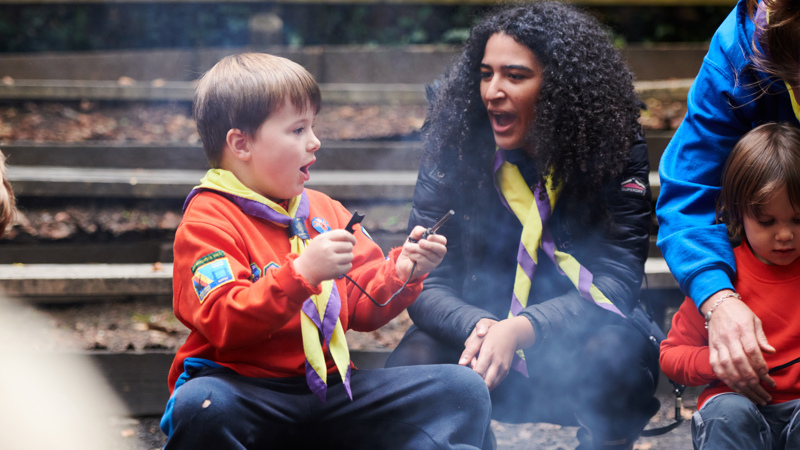
Take a look at our activity information form for parent and carers to share information and obtain their permission for activities, outings and nights away.
POR Chapter 7
Read our policy on emergency proceduresPOR Chapter 9
Read 9.1 about an InTouch system